I’ve been conscripted to help organize the Calgary Crime Writers/Crime Writers of Canada party social at When Words Collide. The party will take place the first day of the conference, Friday Aug 9, from 9 PM to midnight at the conference hotel, the Carriage House Inn. You’re all invited to this free event. We’re working on a fun theme. Stay tuned for more details once we figure them out.
Grinzing
Will and I wrapped up a rainy day in Vienna with a visit to the Sigmund Freud museum, housed in the former apartment/office of the father of psychoanalyis. A self-guided audio tour took us through Freud’s residence, office waiting room, treatment room and den where he wrote his numerous psychology books. Not much remains of Freud’s original furnishings. He brought most with him to England when he left Vienna in 1938 to escape Nazi persecution.
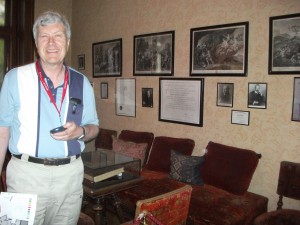
The tour included home movies narrated by Freud’s daughter, Anna. Scenes showed Freud relaxing with his dog in the garden of a house he rented one summer in Grinzing, in the Vienna Woods north of the city. The pleasant, family activies were followed by shots of downtown Vienna during the Anschluss, in March 1938, when Austria joined Nazi Germany. The massive, cheering crowds and giant swastika flag suggested Freud was wise to leave when he did.
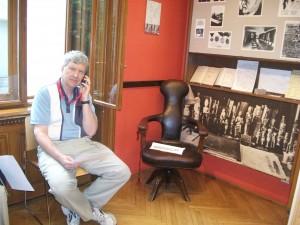
The next day, our last in Vienna, we toured a palace/museum featuring art by Gustav Klimt. From the gardens, we viewed the hilly Vienna Woods. Through our week in the city, I’d been tempted by the woods’ romance due to the title of the famous Johann Strauss’ waltz Tales From the Vienna Woods. We stayed away, figuring the woods were just trees, like I could see at home, and bound to be disappointing. With decent weather and the major Vienna sites under our belts, we decided to go anyway.
The bus travelled through Grinzing, now absorbed into the greater Vienna as an upscale suburb. The driver let us out at the end of the line. We walked uphill through forest broken by glimpses of the city below. Since any kind of viewpoint looked too far out of our reach, we were all set to catch the bus down when another bus came roaring up. It turns out that only some buses stop a little past Grinzing while others go to a large parking lot at the top the highest hill in Vienna. We followed people to a restaurant, cafe and deck with spectacular views of the city. Enjoying our pricey beer, we ducked in and out of spitting rain.
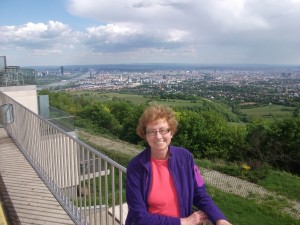
No dout this viewpoint is packed on warm, sunny weekends. This marginal, week day it was quiet and one of the high lights of our Vienna trip. Had the weather been better, we’d have walked down to Grinzing on a trail through open meadow. Instead, we missed stopping in the historic village centre on our bus ride back to the city.
If I return to Vienna, and have a beautiful week day, I’d spend it in the Vienna Woods, hiking through paths to this panoramic lookout and Grinzing.
Vienna – with a literary touch
Last fall, I wrote a series of blog posts about my encounters with literary England and Wales. My trip to Austria and the Czech Republic this spring was less literary, not because those countries haven’t produced great literature – Kafka is integral to Prague and Goethe, while German, travelled everywhere.
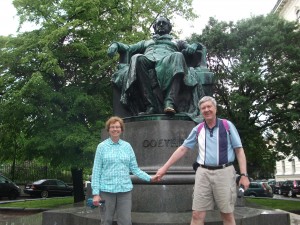
But, in general, writers from middle Europe aren’t part of my literary tradition, so I didn’t seek them out.
Normally, my blog posts relate, in some way, to writing. But it’s summer and I’ve just returned from a long trip. So I’ll relax my standards and blog about my travels, inserting literary matters as they happen.
Our first day in Vienna, we encountered a major one, although we didn’t know it at the time.
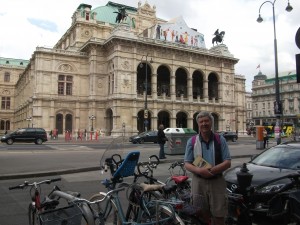
Tired from our over-night flight, under overcast skies, we set out on a walking tour of central Vienna, with Rick Steeves’ Kobo tour as our guide.
At a park featuring statues honouring the Holocaust, the sky looked ready to burst. We ducked under the adjascent Mozart cafe’s huge awning and spent an hour drinking cappucino (me) and beer (Will) while watching the deluge. We later learned that Graeme Greene wrote his novella The Third Man at the Mozart Cafe. The story, set in post World War II Vienna, was later filmed in the city.
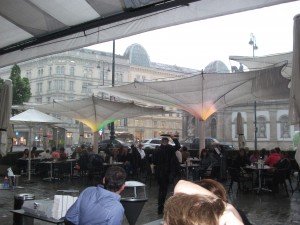
The Britsh Film Institue judged The Third Man the best British movie of the twentieth century. According to Wikepedia, Greene wrote the novella with the movie in mind (he later wrote the screenplay), which shows that books written from movies aren’t always slight.
Now that I’m home, I look forward to watching The Third Man again for the Vienna landmarks, like the Wiener Riesenrad (or Prater) ferris wheel. A few days into the trip, we considered riding the giant wheel after our bike ride through the Prater park. But the skies opened once again and sent us pedalling to shelter.
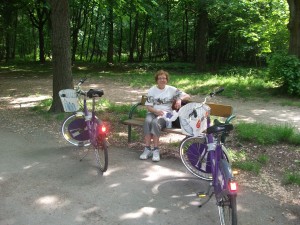
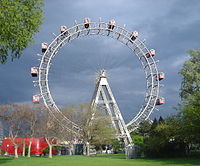
Mosquito Repellent Haiku
Bounce sheets
fastened around our patio table umbrella.
It works!
Hello summer
First day that really feels like summer. Under blue skies, eleven of us enjoyed our annual bookclub potluck lunch in our backyard. We spent more time discussing the flood than books, but came up with our list for next year. Looks like a good selection, with settings all over the world.
Flood
Relatives and friends, hearing and viewing reports about the Calgary flood, have been calling and e-mailing to ask if we’re okay.

We live fairly high-up from the river and have escaped the flood’s effects – so far. Life, for us, functions normally, aside from cancelled events and inconveniences. My heart goes out to the numerous southern Alberta residents forced to evacuate, those with flood-damaged property and, most of all, the loved ones of people who lost their lives in High River.
While we feel somewhat like outsiders to this local disaster, Will and I can understand. This is the third major flood we’ve experienced in less than year, in three separate world locations.
The first one, which impacted us most, was last fall’s flood in York, UK. Prior to the trip, we booked an apartment along the river for five nights. It came with bicycles and we had visions of biking along the river pathway, as well as making day trips to sites outside of town, such as Castle Howard, the grand estate where the TV series Brideshead Revisited was filmed. None of that happend.
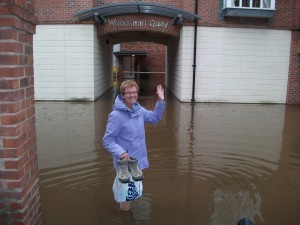
After several days of torrential rain, the river spilled over the pathway and rose up buildings that now looked like homes in Venice. Water filled our apartment building courtyard, the only access in and out. Our worst morning in York, we waded through murky, thigh-high water dressed in our bathing suits, ducked into a public washroom and changed into our street clothes.
Last month, when I left for a holiday in Austria and the Czech Republic, I joked that I hoped a flood wouldn’t hit us again. It did, during the final week of our trip, in Prague, following five days of heavy rain. As in Calgary, the country declared a state of emergency and called in the army. Soldiers erected flood walls and sandbagged threatened areas and buildings. One block from our house, we stepped over barricades to go to our favourite bakery. Subway lines were closed, as were city parks due to the risk of trees falling due to soggy ground. This resulted in us changing several sight-seeing plans and prevented us from making a day-trip to Terezin, to view the concentration camp, because the routes to the town were under water and Terezin was evacuated. Instead of evenings spent strolling the iconic Charles Bridge – it was closed – we joined the multitude of tourists and locals photographing the swollen river. Water rushing over paths and parks made us glad to be distant from the flood’s worst effects.

I’m back …
… after a 40 day holiday to Austria, the Czech Republic and Toronto. When I left, the trees in my yard were barely budding. I returned to summer bloom – and mosquitoes.
After such a long time away, I’m eager to return to writing. Calgary’s June rains (plus the bugs) might help tie me to my computer and writing room, although I don’t want to miss our short summer weather. My priority, for the next month, will be enjoying the warm air and blue skies, getting exercise and healthy eating. I managed a fair bit of the first ones on the holiday, but couldn’t resist gorging on Austrian and Czech pastries, schnitzel and dumplings, among other arterty-choking cuisine, and inexpensive wine and beer.
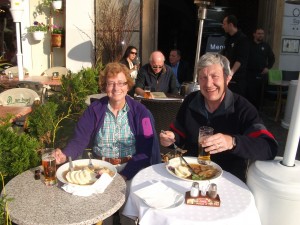
A look at my blog, shows I haven’t posted since January. Yikes. Last winter and spring, I was focused on finishing the third draft of a new novel before leaving on the trip and let the blog slide. I’ll get back to it during this more relaxed summer period. Tune in for some travel-related posts.
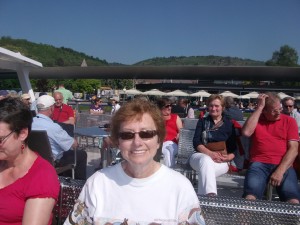
Always the Bad Guy
When Words Collide multi-genre writing conference comes to Calgary Aug 9-11, 2013. I’m registered and looking forward to a busy, informative and fun three days. Last year, I participated in three panels. You can listen to podcast of one called Always the Bad Guy.
The discussion wound up focussing on anti-heros, a topic I hadn’t given much thought to before the panel. Interesting to wing it in front of an audience.
CBC Book Sale
Calgary Readers: Check out the CBC Book Sale for some really great finds.
Book Club with Fran
I hosted a fun, informative book club gathering yesterday featuring Alberta author Fran Kimmel and her novel The Shore Girl. 
The Shore Girl is short-listed for this year’s Alberta Readers’ Choice Award. Voting is now open to the public. Prize is $10,000. The winner will be announced at an Edmonton gala on May 25th.